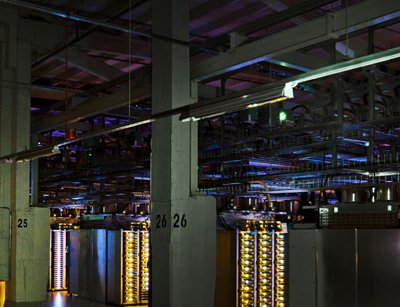An assignee called Exaflop, believed to be Google, has been awarded a patent for a modular data center cooling unit designed filed in 2009 that captures warm air from servers at either end of a data center aisle and cooling coils that cool the air and circulate it back into the data center space.
Google’s Jimmy Clidaras along with the MIT’s William Hamburgen are just two people named as the inventors.
Exaflop, which is registered to a Mountain View, California address, submitted numerous use types for the cooling system, which allows for a number of alterations, to conduct different types of cooling for different data center situations.
It appears to be a way of doing hot aisle containment, and seemingly uses hot aisle containment in a modular style, with skid mounts used on the housing to allow the apparatus to move, moveable cooling coils and fans which can be redirected.
The Patent puts forward: “A data center cooling system, comprising: a plurality of cooling modules aligned end-to-end in one or more rows; sides on the cooling modules defining openings for capturing warm air from electronics racks mounted to the cooling modules; and ends on the cooling modules defining openings for passing air into and out of the cooling modules along a row of cooling modules, wherein the cooling modules in a row are positioned to have open spaces between adjacent cooling modules and wherein the spaces are sufficiently sealed from a data center workspace to form a warm air capture zone”
The modular cooling unit uses one or more fans mounted on top of on replaceable mounts with associated fan controllers. The apparatus is positioned to circulate the air from the electronics, through cooling coils and into the data center.
The cooling coils can also be mounted horizontally below the fans and can be rotated into a vertical position for servicing. They can also be mounted in a V formation to form a cool-air plenum to separate air from the warm air capture plenum.
The patent document shows the modular unit is about 6ft x8ft long.
It also shows that the applicant has designed the modular cooling unit to provide seismic support.
The unit is contained by a barrier that has sealed openings for permitting the passage of cooling water piping to the cooling coils
The document summary says the design has been submitted with flexibility in layout for cooling in mind and to provide for high volume heat removal “using relatively simple and inexpensive equipment”
“In addition, in certain implementations, much of the equipment may be pre-fabricated and tested at a factory, and then quickly installed and commissioned on-site, so as to provide for faster "go live" time for a facility, and to allow for less expensive, but more dependable, equipment construction.
“In general. . . modular units may be provided to capture warm air that exits rack servers or other such devices to prevent the warm air from escaping and mixing with the ambient air in a data center. The modular units may then cool the captured warm air and provide the cooled air back into the ambient space, where it can be circulated through the rack servers or other equipment again. The modular units may be configured so that captured air may pass between the units, so that if one unit is not working well or is otherwise overloaded, air from it may pass to other units. Also, space may be provided between units that are aligned in a row in certain implementations, and warmed air may be captured in the space and then drawn into adjacent units. In this manner, for example, cooling capacity may be matched better to heat generated by the cooling load (the electronic equipment), particularly if the load varies from rack to rack or if the load changes over time.
“In addition, the units may be spaced, in X and Y directions, so that structural columns in a facility (or other interruptions in a floor plate) are all or mostly located in the empty warm air plenum created in a row of cooling units, in the spaces between cooling units. In this manner, the columns can effectively disappear in the data center space.”
The document also details the various use cases for the modular cooling unit, which you can view in more detail here.

